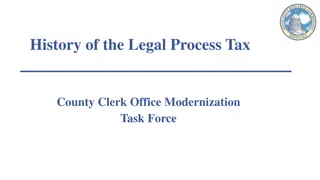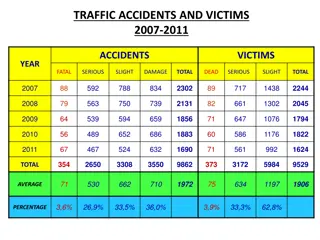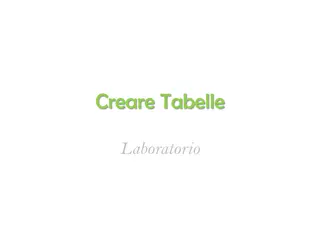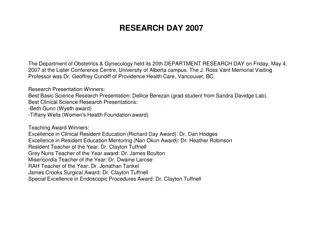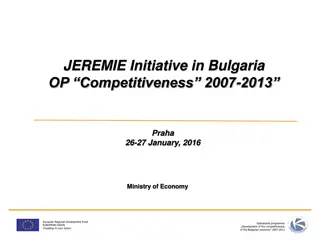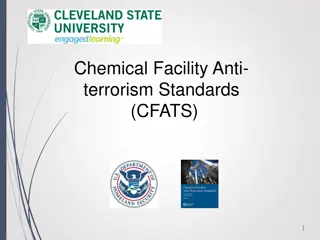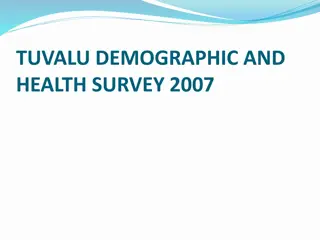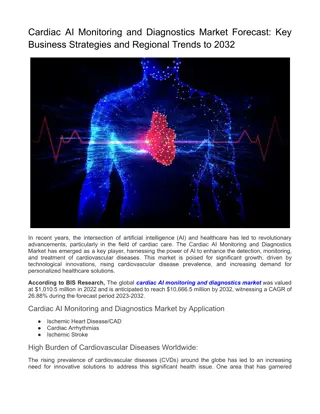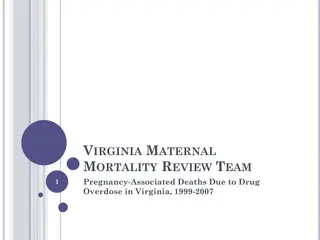GLNE 010: Aims in 2007
This study aims to estimate sensitivity and specificity for detecting colorectal adenocarcinoma and screen relevant neoplasms using different biomarkers. It also seeks to determine the effectiveness of stool vimentin methylation compared to FIT and establish high-quality biosamples for validation. The project details registrations, completion rates, and activation steps involved.
Download Presentation

Please find below an Image/Link to download the presentation.
The content on the website is provided AS IS for your information and personal use only. It may not be sold, licensed, or shared on other websites without obtaining consent from the author.If you encounter any issues during the download, it is possible that the publisher has removed the file from their server.
You are allowed to download the files provided on this website for personal or commercial use, subject to the condition that they are used lawfully. All files are the property of their respective owners.
The content on the website is provided AS IS for your information and personal use only. It may not be sold, licensed, or shared on other websites without obtaining consent from the author.
E N D
Presentation Transcript
GLNE 010: Aims in 2007 1. Estimate the sensitivity and specificity for a. colorectal adenocarcinoma b. screen relevant neoplasms (SRN) (colorectal adenocarcinoma, high grade dysplasia, and adenomas 1cm) for stool (vimentin methylation) and circulating (galectin-3 ligand, ctDNA, other future) biomarkers 2. Determine whether stool vimentin methylation sensitivity >FIT same specificity of stool vimentin methylation test.
GLNE 010: Aims in 2007 3a. Estimate sensitivity and specificity of the above individual binary biomarkers in combination with FI. 3b. Determine if sensitivity of stool vimentin methylation + FIT > FIT 4. Establish an highly quality FDA GCP biosamples for future validation and discovery.
Study Design GLNE 010 Stool Collection Blood Collection Urine Collection Data Elements FIT Preparation procedure Colonoscopy
Registrations, Evaluable, Case Rates Registrations: 5,154 Evaluable Completions: 4,669 (88%) Number of Events to Date: 29 Cancers: 10 (0.2%) High Grade Dysplasia: 19 (0.4%) Case Proportion: 0.6% Projected Case Proportion: 1.5% Large adenoma case proportion: 14% This was complete in 2013 We recruited 4,669 eligible in 18 months.
Project Activation Steps 1 1. Finalize protocol Required 7 months of internal EDRN review 2. Submit, negotiate Core Funds, Set aside funding 3. IRB Review 8 EDRN Institutions, 3 new institutions Alliance 4. CDAs, MTAs Negotiate, execute with three different companies
Project Activation Steps 2 5. Subcontracts Execute Subcontracts with Each Institution 3 Separate Funding pools Overhead problems 6. Training Site Visit 7. Procuring Supplies Manufacturing 1000s of kits for shipment
GLNE 010 Current Status SubContract Date Document OCA Sent to Site IRB status version 5 (released to sites to submit in May 2017) Estimated accrual per month Estimate recruitment start date SubContract Date Document Complete SubContract Date Document Sent OCA SITE ID Site name Training visit? Sponsor Submitted-under review at IRB 661 University of Michigan 5 Not needed Late October Internal-ready NIH - Core At UM under review in contracts office At UM under review in contracts office University of North Carolina Approved 5 date pending Late October Clinical Genomics 9/7/2017 Not yet submitted by site 672 University of Minnesota 15 not scheduled Uncertain Clinical Genomics 9/8/2017 At UM under review in contracts office University of Calgary Approved 50 Completed August 21,2017 Mid-September Volition 9/7/2017 Submitted-under review at IRB Approved pending contigencies At UM under review in contracts office At UM under review in contracts office University of Washington 5 date pending Late October Clinical Genomics 9/7/2017 662 Dana Farber CI 5 date pending October Clinical Genomics 8/24/2017 At UM under review in contracts office MD Anderson Approved 5 schedules 9/25/2017 Early October NIH - Core 9/6/2017 Submitted-under review at IRB At UM under review in contracts office Penn State-Hershey Med Center 5 date pending October Clinical Genomics 8/29/2017 conducted in 2016. Lab staff training for DKFZ central lab October 4-5 in Michigan At UM under review in contracts office DKFZ Approved at all sites 125 Mid-October Volition 8/18/2017
GLNE 010: Aims in 2007 It has been a decade! Science marches on!
Exact Sciences Panel Exact Panel Sensitivity By Stage Histology Imperiale Imperiale TF et al. N TF et al. N Engl Engl J Med 2014;370:1287 J Med 2014;370:1287- -1297. 1297.
Issues with Stool DNA and Fecal Occult Blood Tests FIT test x 1 only. Serial testing may alter FIT performance. High cost Complex collection and shipping procedures Universal FIT Screening Programs: 40% Refuse the Test Exact test improved over FIT but insufficient for adenoma (non-invasive neoplasm) Exact did not collect blood!
Key Challenges in Colon Cancer Early Detection Enhancing Adherence to Current Screening Guidelines 40% of USA population non-adherent Barriers: Cost, discomfort, cultural taboos Strategy: Circulating Markers Tayloring Colonoscopic Screening to Individual Risk Select high risk for endoscopic screening. Rest no screening. Specific demographic risk groups (genetic groups, African Amer) Strategy: High sensitivity (99%) biomarker panels
Key Challenges in Colon Cancer Early Detection Persistently Positive Biomarker Tests, Neg Endoscopy Stool methylated DNA panels report 5% false positives Potential Sources: Upper GI; flat adenomas, serrate lesions Non-GI sources Strategy: Develop longitudinal subsets; specialized endoscopy (molecular probes); upper GI; more extensive screening (pancreas, extra GI source)
Key Challenges We Can Address Circulating Markers Can we identify a panel that can equal FIT stool screening? Must a circulating biomarker panel be equal to or beat FIT to be useful?
Sources of Circulating Markers Glycoproteins Circulating Genetic Material Methylated genes appear to have stronger signals Carcinogenesis Associated Genes Rate limiting control of pivotal inflammation mediators Antibodies
A Strong Circulating Biomarker Galectin-3 Ligand--Glycoprotein Beta-galactoside-binding protein implicated in tumor progression and metastasis. In colon cancer sera, a 40 kDa band distinct from mucin, CEA. This band was also detected by Lotus tetragonolobus lectin and Erythrina cristagalli lectin (ECL), indicating that it is a glycoprotein containing fucose and N- acetyllactosamine. R. Bresalier, MD Anderson/GLNE CVC EDRN
Modeling: Galectin3 Ligand , CYFRA21, CEA Using 300 EDRN Samples AdvancedAdenoma_vs_Normal LateCRC_vs_Normal 1.0 1.0 0.8 0.8 0.6 0.6 Sensitivity Sensitivity 0.4 0.4 0.2 0.2 Model 1 : AUC=0.807 Model 2 : AUC=0.783 Model 3 : AUC=0.813 Model 4 : AUC=0.817 Model 1 : AUC=0.916 Model 2 : AUC=0.908 Model 3 : AUC=0.903 Model 4 : AUC=0.903 0.0 0.0 1.0 0.8 0.6 0.4 0.2 0.0 1.0 0.8 0.6 0.4 0.2 0.0 Specificity Specificity Model 1- logistic regression based on forward selection: Galectin3 Ligand , CYFRA21, CEA are selected, their coefficients are determined using logistic regression model.
Circulating Methylated Genes from Clinical Genomics IKZF1, BCAT1
Carcinogenesis Mechanism Based Gene Markowitz Laboratory PGDH as Predictor of Adenoma Recurrence
Autoantibodies Lampe Laboratory EDRN ROC analysis of biomarker combination calculated for CHS and EDRN samples Panel? Samples? Case? category? Case? Ctrl? ? ? BAG4+IL6ST+VWF+EGFR*? Case? Ctrl? ? ? BAG4+IL6ST+VWF+CD44*? ? ? ? ? ? ? n? n? ? ? AUC? 95%CI? Sens? 95%CI? n? n? ? ? AUC? 95%CI? Sens? 95%CI? All? cases? 66? 66? 0.81? 0.74-0.88? 40.9%? 0.23-0.65? 66? 66? 0.79? 0.72-0.87? 42.4%? 0.15-0.64? ? ? ? ? 0.84? 0.76-0.92? 50.0%? 0.16-0.78? CHS? 0-1? year? 31? 66? 0.86? 0.78-0.93? 51.6%? 0.23-0.77? 31? 66? 1-3? years? 35? 66? ? 0.77? 0.68-0.86? 31.4%? 0.14-0.54? 35? 66? ? 0.75? 0.65-0.85? 34.3%? 0.09-0.54? 4-protein? All? adenomas? 20? 23? 0.83? 0.68-0.95? 55.0%? 0.20-0.90? 20? 23? 0.85? 0.66-0.95? 52.6%? 0.21-0.95? ? ? EDRN? ? AA? +? stage? I+II? 21? 23? 0.88? 0.76-0.97? 61.9%? 0.29-0.95? 21? 23? 0.82? 0.75-0.98? 60.0%? 0.25-0.95? ? ? All? cancers? 23? 23? 0.90? 0.80-0.98? 65.2%? 0.35-0.96? 23? 23? 0.88? 0.78-0.98? 54.5%? 0.27-0.95? ? ? All? cases? 43? 23? 0.87? 0.76-0.95? 55.8%? 0.35-0.91? 41? 21? 0.85? 0.74-0.95? 51.2%? 0.32-0.90? ? ? ? 0.84? ? ? ? 0.84? 0.75-0.94? 50.0%? 0.13-0.78? Prediagnostic? 56? 54? 0.77-0.91? 46.4%? 0.27-0.73? 32? 33? CHS? 0-1? year? 25? 54? ? 0.87? 0.79-0.94? 56.0%? 0.28-0.80? 13? 33? ? 0.84? 0.73-0.96? 46.2%? 0.00-0.85? 4-protein? +? glycomic*? ? 1-3? years? 31? 54? ? 0.82? 0.73-0.91? 38.7%? 0.23-0.71? 19? 33? ? 0.84? 0.73-0.95? 52.6%? 0.21-0.84? All? adenomas? 21? 20? 0.88? 0.77-0.94? 72.2%? 0.28-0.94? 17? 21? 0.80? 0.65-0.94? 52.9%? 0.24-0.88? ? ? AA? +? stage? I+II? 19? 20? 0.91? 0.83-1.00? 78.9%? 0.37-1.00? 18? 21? 0.86? 0.75-0.97? 61.1%? 0.33-0.94? EDRN? ? ? All? cancers? 21? 20? 0.93? 0.85-1.00? 85.7%? 0.43-1.00? 20? 21? 0.89? 0.79-0.98? 65.0%? 0.35-0.95? ? ? ? 0.90? ? ? ? 0.85? 0.75-0.95? 59.5%? 0.35-0.86? All? cases? 39? 20? 0.82-0.98? 79.5%? 0.41-0.95? 37? 21? *EGFR?or?CD44's?sialyl?Lewis?A?and?X?information?was?added?to?the?combinations.?Coefficients?were?calculated?for?CHS?All?cases.?AUC:?area?under?the?curve,?CI:? confidence? interval,? Sens:? sensitivity? at? 90%? specificity? ? ?
Antibodies to Nucleosomes Volition, Inc Family of 39 Different Antibodies, 5 key families Specific DNA Modifications Histone Variants Histone Modifications Nucleosome Protein Adducts Total Nucleosomes
Panel of 4 Nucleosome Antibodies, Serum Assay Preliminary Validation by Volition, Inc 4800 Symptomatic Patients Undergoing Colonoscopy Sensitivity 81%, Specificity 78% for invasive Colorectal Neoplasms Preliminary Screening Detection of Stage I Cancers Sensitivity 74% at Specificity of 90% High Risk Adenoma ( 1 cm, dysplasia) Sensitivity 61% @ Specificity of 80%; 530 symptomatic patients
Tayloring Colonoscopic Screening to Individual Risk Select high risk for endoscopic screening. Rest no screening. Strategy: High sensitivity (99%) biomarker panels
Key Challenges We Can Address Tayloring Colonoscopic Screening to Individual Risk (goal of 99% sensitive marker panel at specificity of >70%) If we combine circulating markers with FIT will be equal or surpass Exact Sciences panel? Will vimentin beat the Exact panel? Will digital sequencing analytical technology improve stool DNA sensitivity to get us to the 99% target? Will the microbiome be the component that pushes stool panes to the 99% target?
Managing Accrual to Ensure Successful Completion Group A--Reopened 50-59 yr First colonoscopy Group B--Reopened 60-69 yr Prior colon exam, none within 108 months Group C 60 yr No prior colon exam Group D 70 yr No prior OR prior colon exam within 108 months Group E 65 yr Prior advanced adenomas (>1 cm, sessile) No colon exam within 36 months Group F 50-64 yr Prior 3-10 tubular adenomas, no colon exam within 60 months OR Prior >10 adenomas, no colon exam within 36 months OR Prior advanced adenoma, no colon exam within 36 months OR Prior adenoma with high grade dysplasia, no colon exam within 36 months OR Sessile serrated polyps, no colon exam within 60 or 36 months depending upon size
Comparison to Equivalent Studies Age 50-59 60-64 65-69 70-74 75 CRC Event HGD Event 0.4% Exact 29% 8% 37% 17% 9% 0.7% PRESEPT BliTz 35% 27% 21% 11% 6% 0.8% 0.7% GLNE 42% 18% 21% 21%* --- 0.2% 0.4% 36% 23% 25% 13% 4% 0.7% 0.7%
Registrations on Study 120 6000 100 5000 80 4000 Cumulative accrual Weekly accrual 60 3000 Weekl y 40 2000 20 1000 0 0 10/1/2011 1/1/2012 4/1/2012 7/1/2012 10/1/2012 1/1/2013 4/1/2013 7/1/2013 10/1/2013 1/1/2014
German Screening-Biomarker Trial (BliTz H Brenner) N = 7,950 Study Duration: 7 yrs
Colonoscopy Screening Rates USA: Germany : 61% 16%
Why Exact, PreSept, BliTz with Higher Event Rates Exact Required 2/3rdenrollments 65 yrs. More community sites. PreSept Enrolled first colonoscopy screens only. Half enrollment in Germany 65% 60 yrs Blitz Same enrollment as GLNE 010 Entirely in Germany (16% colonoscopy screening rate)
Bias Screening population have access to care, including minorities on trial. Minority accrual 17%. Pathologist Bias? Fewer academic pathologist make high grade dysplasia diagnosis
Inferences Rapid changes in standard of care in USA from 2007 to now. Low screening adherence in Germany (16%) results in published cancer event rate of 0.7%. Same as in literature. Downstaging from invasive carcinoma to advanced adenomas.
Plan Cancer Endpoint Only Dysplastic adenomas as endpoints degrade biomarker performance. Reduces the likelihood of successful identification of early detection biomarkers for colorectal neoplastic disease. increases barriers for success to the very biomarkers that the EDRN exists to discover and validate. Degrades the usefulness of the repository samples generated by GLNE 010 for future validation trials.
Plan Substantial enrollment in Germany USA enrollment restricted to 60 yrs, first colonoscopy only Incremental industrial funding available (meets Executive Committee requirements)
Analytical Validation Galectin-3 Ligand Assay Bresalier Laboratory Invented Assay BRL UCLA Converted to Luminex Assay Going to run at UCLA Vimentin Methylation Markowitz Laboratory Invented Assay BRL University of Maryland Converted to qPCR Now extracted from 88 subjects
Team Projects: Aims Identify biomarkers that predict the presence of advanced colorectal adenomas Discovery in blood, tissue, stool Promising markers go to validation in blinded reference sets from previous GLNE CVC samples Validated biomarkers to includ in GLNE 010 (cross-sectional colon validation study)
Grady Laboratory Methylated NTRK3 in Stool DNA-based assay NTRK3 promoter methylation in stool samples. (MethyLight) Methylated * Patients n n % Adenocarcinoma 20 11 55.0% Adenoma 20 9 45.0% Normal *Use the same cutoff as the tissue-based MethyLight assays. 16 2 12.5%
Microbiome Kostic et al, Cell Host and Microbiome, In press
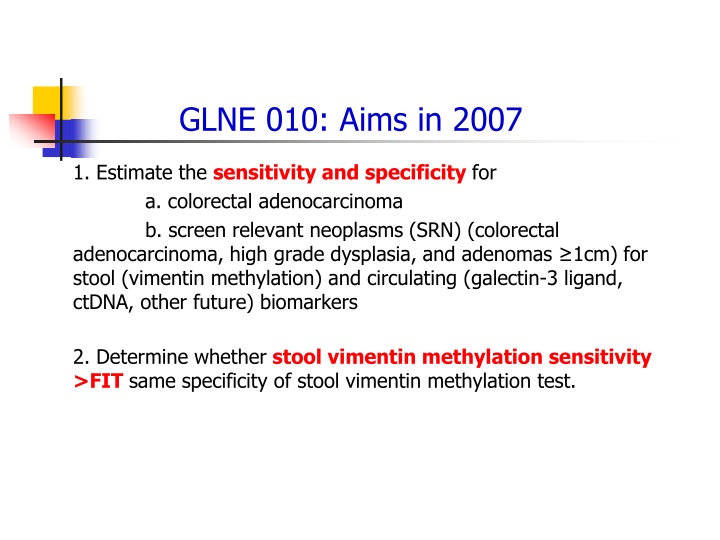

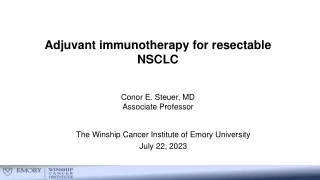
![❤[PDF]⚡ Space Exploration 2007 (Springer Praxis Books)](/thumb/21607/pdf-space-exploration-2007-springer-praxis-books.jpg)






